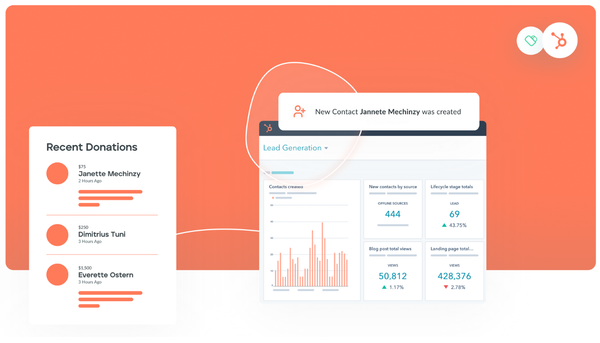Choosing Fundraising Software For Your Nonprofit, Part 2: Features

This is part of a 3 part series on how to choose fundraising software for your nonprofit. If you missed Part 1, click here to read our first post about pricing.
Continuing our series on how to choose a new fundraising solution for your organization, let’s chat about features & functionality.
As with any software on the web, fundraising solutions come with all types of features. Before you start your research, a great thing to do is to write down the core functionality that your organization needs. This way, you can quickly weed out solutions that might offer more or less than you need, getting you the best value on your investment.
Generally, we assume all solutions have a way for your to track donations and see donor information (name, email, etc), so we’re treating those features as a given. Below you’ll find our list of other features that your solution should definitely have.
Embeddable Forms
This is one of the most important pieces to consider. There are generally two options if you want donors to be able to give from your website: Embed a form or send them to a separate donation page.
A general rule of thumb for e-commerce has always been to keep interested consumers on your site through purchase. Think about when you shop on Amazon. You never have to leave the “amazon.com” URL in order to complete your purchase. From searching for your product and selection to payment and confirmation, it’s all on the same site.
An embeddable donation form helps you mimic that process on your site. By putting the form directly on your site, you will never have to worry about pop-up blockers or scaring potential donors off by sending them to another site just to give. What’s more, keeping them on your site ensures you have full control over the branding, content, and message.
Recurring Donations
More and more, online consumers are used to being on some type of subscription plan; from Netflix to their local newspaper, monthly subscriptions are becoming the norm. This is no different for charitable gift giving, and can be hugely beneficial for your organization. Knowing that you have a set amount of donations to be processed each month is hugely important in planning your budget in advance.
Recurring plans are also a great way to breed loyalty. Recurring donations lower your cost of acquiring donors, which in turn gives your organization more revenue to put towards your cause. In fact, it costs 5 times more to attract a new customer (in your case, donor) than it does to retain a current one.
Donor Self-Service
Related to the recurring donations above, your new donation system should have a way for donors to manage their own plans. Whether their credit card is about to expire or they were a victim of credit card fraud, having a way for donors to quickly swap in new credit card info on their own will save your organization a lot of time.
Another great feature of having a donor profile is allowing them to access their year-to-date giving totals. This is especially important come tax time, when they can take a peek at their year-in-giving without your organization’s office needing to send out individual summary letters!
Email receipt
After a donor gives, sending a quick note that shows the amount donated, as well as any tax related information for their records is essential. In our experience, this email does not need to be too fancy, but rather should provide pertinent information in a timely manner to the donor. A good fundraising platform will allow you to customize this message, getting in your logo and a quick note from your team.
These messages also give the donor a chance to contact you back should they see a mistake with their donation. Plus, as this process should be automated, it’s another time-saver for your staff! Instead of taking time to mail your confirmations, it is delivered instantly, often at no additional cost. Win/win!
(Once you’re collecting donor email addresses, we always suggest setting up an email marketing campaign that continues to update donors on progress. We’ll get into this a little more on the Integrations part of our series.)
Donor covering fees
As we touched on yesterday, <a href="http://help.donately.com/all-things-donations/enabling-donor-pays-fees-feature" target"_blank">enabling the option to have donor’s cover fees is increasingly normal, and even, desired. Instead of only getting, say, $95 of that $100 donation, your organization would now receive the entire $100 when a donor elects to cover these fees. Multiply that out over the course of the year, and you’ve just instantly added a lot of revenue to your bottom line without doing anything extra!
Though you’ll find widely variable figures on what percent of donors will be willing to cover the fees, we’ve found that, at an absolute minimum, over 60% of donors opt to do this. This can be a game-changer for your organization, especially if you choose a system that has entirely fee-based pricing, as the net cost of the software will then decrease that much more. We’ve found that donors love to know that 100% of their intended donation is going to the cause they feel passionately about. For most, adding an extra $5 to their donation is well worth it for that alone.
Customer support
Finally, let’s talk about one piece that isn’t necessarily a “feature”, but is often one of the most overlooked aspects of choosing a new fundraising solution: customer service. This can take many different forms, and entirely depends on the structure of the fundraising software. For example, if the organization is large enough to have a dedicated sales staff, often times the person you talk to first is not who you will be consulting with in the long-term. That may be okay for some organizations and not for others; entirely dependent on your anticipated needs.
Along with getting the general consensus from other users, online reviews are specifically helpful in determining the reputation of the product’s customer service. Read through reviews carefully, and try to identify a few different sites that have reviews to be sure to get the full picture.
Check back for part 3 of this series when we talk more about Integrations!





